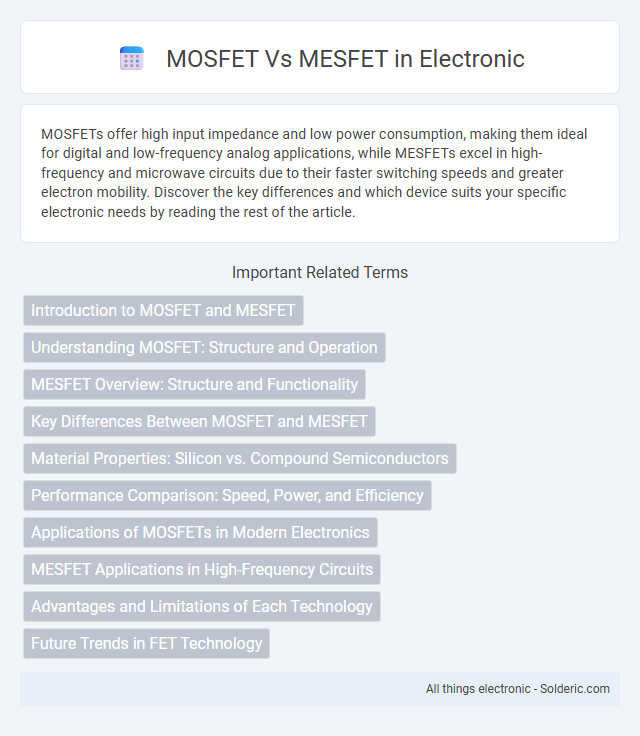MOSFETs offer high input impedance and low power consumption, making them ideal for digital and low-frequency analog applications, while MESFETs excel in high-frequency and microwave circuits due to their faster switching speeds and greater electron mobility. Discover the key differences and which device suits your specific electronic needs by reading the rest of the article.
Comparison Table
| Aspect | MOSFET | MESFET |
|---|---|---|
| Full Form | Metal-Oxide-Semiconductor Field-Effect Transistor | Metal-Semiconductor Field-Effect Transistor |
| Semiconductor Type | Silicon (Si) commonly | Compound semiconductors like GaAs (Gallium Arsenide) |
| Gate Insulation | Oxide layer (SiO2) | No oxide layer; Schottky metal-semiconductor junction |
| Operating Frequency | Low to medium frequency applications | High-frequency and microwave applications |
| Channel Type | Inversion layer channel controlled by voltage | Depletion region channel |
| Input Impedance | Very high input impedance | Moderate input impedance |
| Noise Performance | Lower noise in low frequency | Lower noise at high frequencies |
| Fabrication Complexity | Requires high-quality oxide growth | Simpler gate fabrication; no oxide needed |
| Applications | Digital circuits, power electronics | RF amplifiers, microwave devices |
Introduction to MOSFET and MESFET
MOSFET (Metal-Oxide-Semiconductor Field-Effect Transistor) and MESFET (Metal-Semiconductor Field-Effect Transistor) are essential semiconductor devices used in electronic circuits. MOSFET operates with an oxide layer as the gate insulator, enabling control of current through an electric field, whereas MESFET uses a Schottky metal-semiconductor junction as the gate, offering high-frequency performance. Understanding these key structural and operational differences helps optimize your circuit design for applications ranging from digital switching to RF amplification.
Understanding MOSFET: Structure and Operation
MOSFETs (Metal-Oxide-Semiconductor Field-Effect Transistors) feature a gate insulated from the channel by a thin oxide layer, enabling voltage-controlled conduction with high input impedance. Their structure typically includes source, drain, gate terminals, and a silicon substrate, allowing efficient modulation of current through the inversion layer formed under the gate oxide. This design contrasts with MESFETs, which utilize a Schottky gate and depletion-mode operation, making MOSFETs preferable for low-power, high-speed digital and analog applications due to lower gate leakage and enhanced scalability.
MESFET Overview: Structure and Functionality
MESFETs (Metal-Semiconductor Field-Effect Transistors) utilize a Schottky metal-semiconductor junction instead of the insulated gate found in MOSFETs, enabling high-frequency operations primarily in microwave applications. Their structure consists of a semiconductor channel, commonly GaAs, with a metal gate forming a rectifying contact that controls current flow through depletion region modulation. The absence of an oxide layer in MESFETs results in faster switching speeds and improved performance in high-frequency analog circuits compared to MOSFETs.
Key Differences Between MOSFET and MESFET
MOSFETs (Metal-Oxide-Semiconductor Field-Effect Transistors) use an oxide layer as the gate insulator, enabling high input impedance and low power consumption, while MESFETs (Metal-Semiconductor FETs) employ a Schottky metal-semiconductor junction, suitable for high-frequency and microwave applications. MOSFETs are widely used in digital circuits due to their ease of fabrication and excellent switching characteristics, whereas MESFETs excel in high-speed and high-frequency environments, especially with III-V semiconductor materials like GaAs. The key differences lie in their gate structure, frequency performance, and typical applications across power and RF domains.
Material Properties: Silicon vs. Compound Semiconductors
MOSFETs primarily use silicon, offering superior thermal stability and well-established fabrication technology, making them ideal for a wide range of applications. MESFETs utilize compound semiconductors like gallium arsenide (GaAs), which provide higher electron mobility and faster switching speeds, critical for high-frequency and microwave devices. Understanding these material properties helps you select the appropriate transistor type based on performance requirements and application environment.
Performance Comparison: Speed, Power, and Efficiency
MOSFETs generally offer higher switching speeds and better power efficiency due to their insulated gate structure, which reduces gate leakage current and enables lower power consumption. MESFETs, while capable of operating at very high frequencies suitable for microwave applications, typically exhibit higher noise levels and power dissipation compared to MOSFETs. Your choice between MOSFET and MESFET should consider the trade-offs in speed, power handling, and efficiency relevant to your specific high-frequency or low-power electronic application.
Applications of MOSFETs in Modern Electronics
MOSFETs dominate modern electronics with widespread applications in digital integrated circuits, power management devices, and RF amplifiers due to their high input impedance and low power consumption. They are essential components in microprocessors, memory chips, and analog circuits, enabling efficient switching and signal amplification. Compared to MESFETs, MOSFETs offer superior scalability and integration capabilities for advanced semiconductor technology nodes.
MESFET Applications in High-Frequency Circuits
MESFETs excel in high-frequency circuits due to their superior electron mobility in GaAs substrates, enabling faster switching speeds and lower noise figures compared to MOSFETs. They are commonly deployed in microwave amplifiers, radar systems, and satellite communication devices where high-frequency performance and reliability are critical. Their ability to operate efficiently at GHz frequencies makes MESFETs the preferred choice for RF power amplifiers in wireless communication infrastructure.
Advantages and Limitations of Each Technology
MOSFETs offer high input impedance and low power consumption, making them ideal for digital circuits and CMOS technology, but they suffer from lower frequency performance and vulnerability to radiation effects. MESFETs excel in high-frequency and high-power applications due to their superior electron mobility and robust structure, yet they require more complex fabrication processes and have higher noise levels. Understanding these advantages and limitations helps you select the appropriate transistor technology for specific electronic circuit demands.
Future Trends in FET Technology
MOSFET technology is advancing with innovations in gate oxide scaling and high-k dielectrics to enhance performance and reduce power consumption, making it essential for future low-power electronics and high-frequency applications. MESFET development is focused on wide-bandgap materials like GaN and SiC, enabling devices to operate at higher voltages, temperatures, and frequencies, crucial for RF and power electronics sectors. Integration of 2D materials and nanoscale engineering is driving future trends, bridging MOSFET and MESFET capabilities for ultra-fast, energy-efficient FET devices in next-generation communication and computing systems.
MOSFET vs MESFET Infographic

 solderic.com
solderic.com